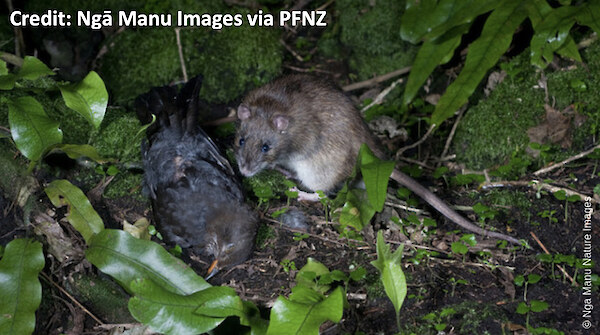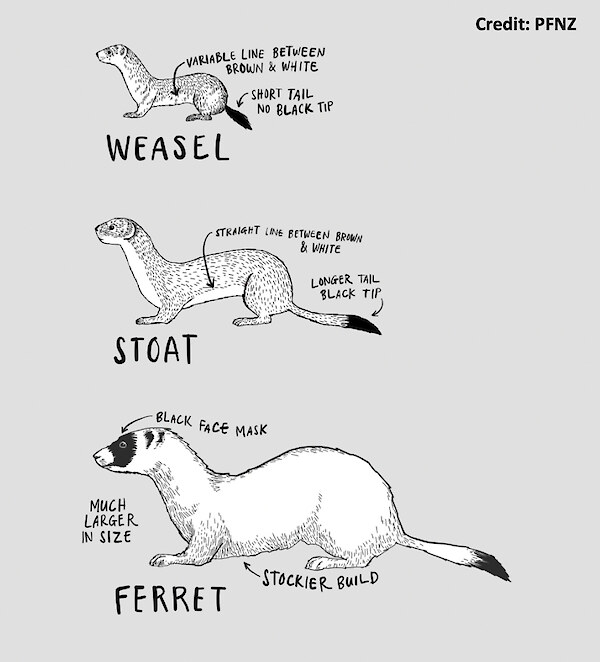Types of konihi (predators) in Aotearoa
Kiore (rats) harm our native plants and animals. They eat almost everything (they are ‘omnivores’), including birds, bats, lizards, insects, seeds and fruit. They live in many different places but like being near people – and our food! They can quickly have lots of babies so are hard to get rid of. In Wellington we have two kinds:
 Norway rats are good swimmers. They can climb trees but normally live on the ground or in burrows. They eat birds and their eggs and chicks. Norway rats have short, thick tails and small ears.
Norway rats are good swimmers. They can climb trees but normally live on the ground or in burrows. They eat birds and their eggs and chicks. Norway rats have short, thick tails and small ears.
 Ship rats are good tree climbers and will eat birds in trees. They have bigger ears and a long tail which is useful for climbing.
Ship rats are good tree climbers and will eat birds in trees. They have bigger ears and a long tail which is useful for climbing.
Paihamu (possums) live across the country and like places with shelter and good food supply. They are awake at night (they’re ‘nocturnal’) and eat trees, berries, nectar and birds’ eggs. Possums can also make cows sick. Possums are about the size of a cat with grey/black/brown fur. They are marsupials which means the mums carry their young in a pouch (like a kangaroo).
Mustelids are a group of animals that harm our native wildlife
 Wīhara (weasels) are the smallest and least common mustelid. They have red/brown fur and a short tail. They eat mice and hunt birds, eggs, insects and lizards. They live in gardens and farmland and are awake at night. Even baby weasels are good hunters.
Wīhara (weasels) are the smallest and least common mustelid. They have red/brown fur and a short tail. They eat mice and hunt birds, eggs, insects and lizards. They live in gardens and farmland and are awake at night. Even baby weasels are good hunters.- Toriura (stoats) have black/brown fur, a pale tummy and a bushy tail. Stoats are very good hunters and kill lots of native birds. They hunt during the day and night and can see, hear and smell very well – so our birds have no chance. Stoats also have lots of babies.
- Torihura (ferrets) are about the size of a small cat and are larger than both stoats and weasels. There are no ferrets in Wellington.
 Feral cats are one of the country’s top predators and we need to try and lower their numbers. Like stoats, they are very good hunters of bats, birds, lizards and insects. Pet cats can hunt our native wildlife, even if they are well fed.
Feral cats are one of the country’s top predators and we need to try and lower their numbers. Like stoats, they are very good hunters of bats, birds, lizards and insects. Pet cats can hunt our native wildlife, even if they are well fed.
 Hetiheti (hedgehog) live all over New Zealand and eat insects, skinks, eggs and chicks. One hedgehog was found with 283 wētā legs in its stomach! Hedgehogs are covered in spines and use these for protection. They hunt at night and sleep right through winter (they ‘hibernate’).
Hetiheti (hedgehog) live all over New Zealand and eat insects, skinks, eggs and chicks. One hedgehog was found with 283 wētā legs in its stomach! Hedgehogs are covered in spines and use these for protection. They hunt at night and sleep right through winter (they ‘hibernate’).
How and why did these predators come to New Zealand?
All these animals came here with people. Māori brought kiore (Pacific rat) and kuri (dog) with them to Aotearoa. European settlers brought Ship and Norway rats, possums, weasels, stoats, cats and hedgehogs. Many of our flightless birds (like the kiwi or kākāpō) were easy targets for these new predators. Wētā, tuatara and our native bats are also at risk.
Rabbits were brought here to so people could hunt them but there were then so many that they damaged farmlands and native bush. Stoats and cats were introduced to control rabbits but that didn’t work and they became a big problem for our native animals. People released possums so we could use their fur but they also took over the bush and there are too many. Hedgehogs were released to help European feel at home. They quickly became a big danger to our native taonga.
What is Predator Free 2050?
Predator Free 2050 is a mission to remove all rats, possums, weasels and stoats from New Zealand by 2050. These animals harm our native wildlife and plants. To help save our native taonga, we must do something. Some of our offshore islands are predator free which is great. Predator Free Wellington will remove rats, possums, weasels and stoats from Wellington where people live, work and play every day. There are other projects across Aotearoa, plus thousands of backyard trappers working together.

